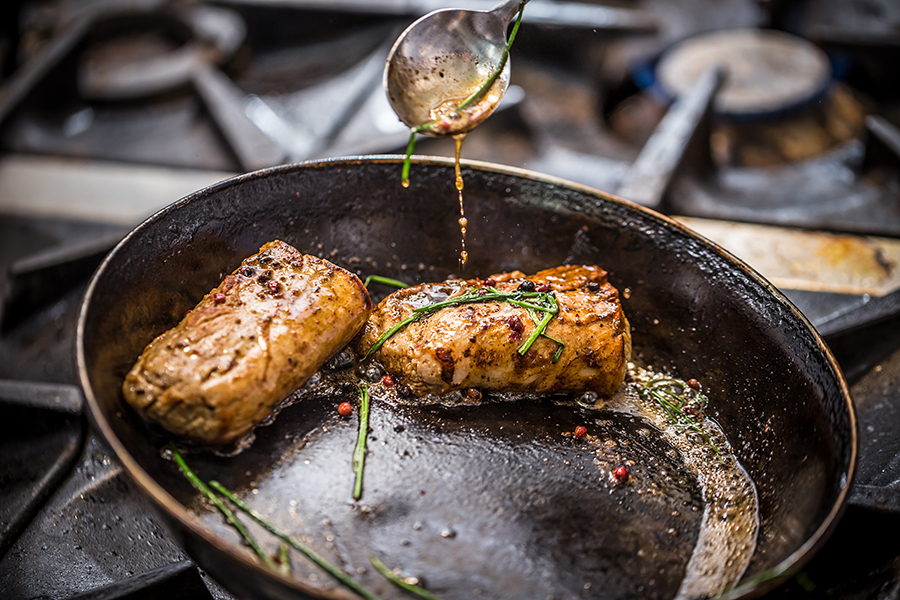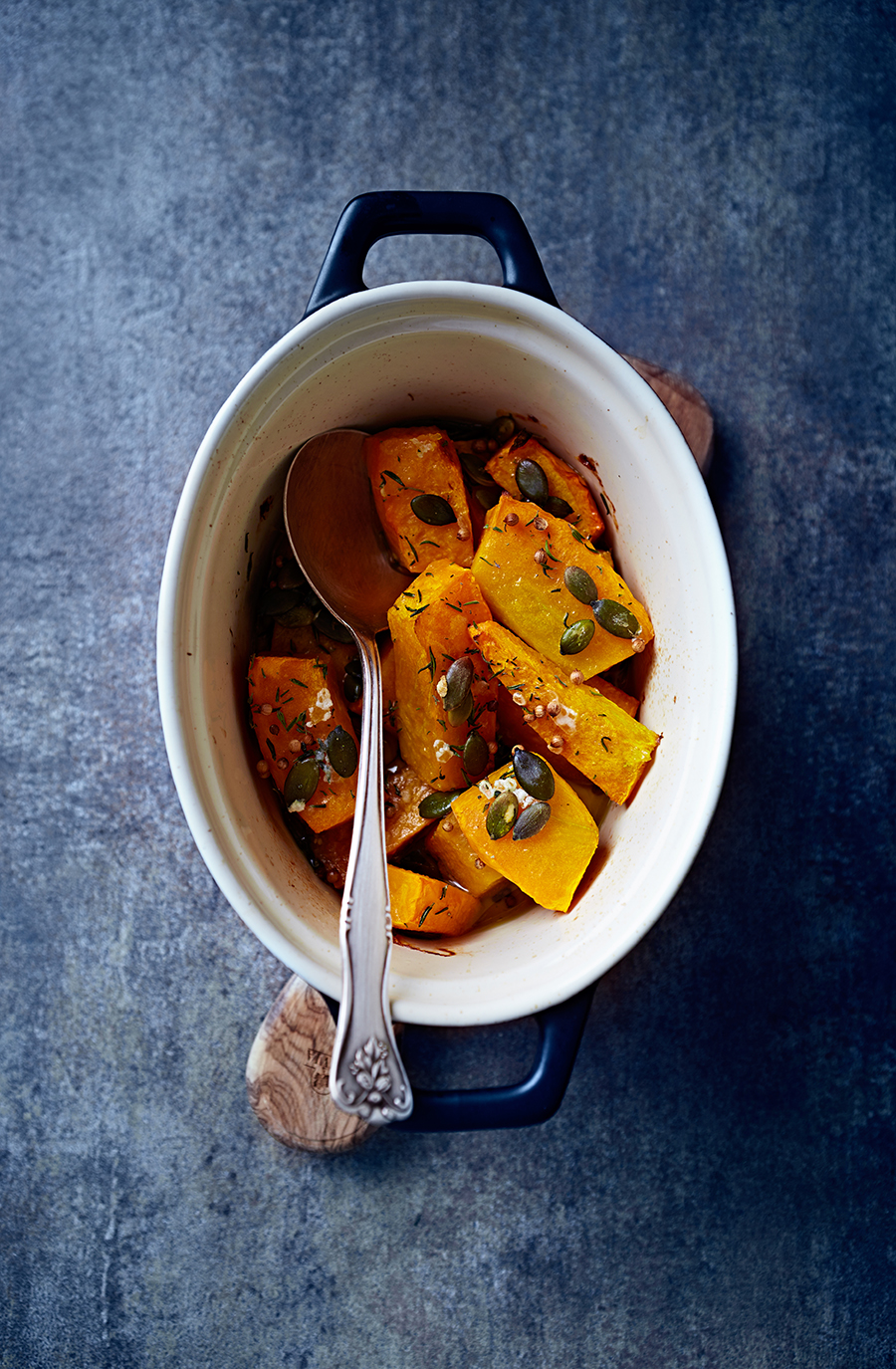Braising 101 (Plus 2 Delicious Multi-Purpose Recipes for Short Ribs and Butternut Squash)

The beauty of braising lies in the journey of transforming large, tough ingredients into something mouth-wateringly tender and delicious. Photo: Klaus Vedfelt/Getty Images
Autumn’s harvest is in full swing and with it, a shift in how we cook. It’s a transition from refreshing salads and smoky steaks off the barbecue served on warm summer nights; it’s now cooler evenings that call for savoury soups and comforting roasts.
This is a very exciting time of year to be in the kitchen. We get to revisit cold-weather cooking techniques and ingredients, and bring all the classic comfort foods back to the table. It’s the season for the craving-inducing pairing of apples and cinnamon and the invasion of pumpkin spice in every food item at the grocery store. Plus, nothing is more warming than the promise of hearty soups, stews and pot roasts, nor compares to the aroma of chicken stock bubbling on the stove and how it permeates throughout the house.
Braising, which comes from the French word braiser, is the quintessential cold-weather culinary technique that infuses food with rich and complex flavours that develop further with cooking. It combines dry and moist heat cooking methods to completely transform a humble piece of meat or vegetable into a melt-in-your-mouth morsel of deliciousness. For a lot of home cooks, braising might come across as a very complicated and time consuming process. But this is far from the truth. It’s straightforward and also a skill all home cooks should possess.

Braising can be summed up in three easy steps. First, brown the main ingredient (meat, seafood or vegetable) in a heavy bottom pot or Dutch oven, using enough fat (oil or butter) to coat the bottom. The goal is to deeply caramelize all sides, which adds flavour and colour to the braising liquid.
Second, add in aromatics such as vegetables, herbs and spices, and then deglaze the cooking vessel with a liquid like stock, wine, beer or even water. The amount of liquid is forgiving, as long as the main ingredient is half covered. An important tip is to scrape and loosen up all the brown sticky residue (fond in French) at the bottom of the pot as the liquid comes up to a simmer to incorporate those caramelized bits into the stock. This helps build the foundation for flavour.
Last, bring the liquid to a simmer, covering and cooking it over low heat. Alternatively, place the pot in a 300 F oven, which slowly and gently cooks and tenderizes the braising product. Slow cooking with moist heat breaks down collagen and connective tissues, resulting in maximum tenderness. This is how rubbery tough pieces of meat like osso buco or short ribs become fall-off-the bone tender. Cooking octopus in water with lemon and herbs results in a flavourful treat from the ocean. A quick simmer of fresh tofu in soy sauce, garlic and sugar becomes the ultimate companion to a bowl of steaming jasmine rice.
Cooking times can vary depending on the product being used. For tougher cuts of meat, two to three hours is sufficient. But for squid or octopus, one hour is long enough to prevent it from becoming too soft. Root vegetables only need twenty to thirty minutes to absorb flavours and become toothsome.
The versatility of this one-pot style of cooking gives you the freedom to create a range of flavour profiles simply through the use of different flavourings and seasonings. Start with garlic and onions. Add aromatic vegetables like carrots, celery and tomatoes for freshness. Include herbs and spices for depth. Common options include strong herbs like rosemary and thyme, while cumin, coriander seeds or spice blends, like ras el hanout and baharat, add sweet aromas and warming flavours.

Slight variations, while using the same techniques, can create the most comforting meals with ease. Chicken legs take an Italian spin with a can of crushed tomatoes and a couple sprigs of fresh basil before they’re finished with grated parmesan cheese. Create a Moroccan-flavored feast by adding cumin, cinnamon and allspice to lamb shanks. Soy, ginger and star anise is the foundation for a Chinese red braise in which you can soak chunks of pork belly.
Braising is more than a cooking technique, though. It’s one of the foundations of cooking. The beauty lies in the journey of transforming large, tough ingredients into something mouth-wateringly tender and delicious. The balance of effort, time, cost and flavour is also an excellent reason to braise. With minimal work, inexpensive ingredients become a crowd-pleasing centrepiece that makes the cook look like a culinary hero. And who doesn’t want that?
Recipes
Below are two fall-harvest-friendly recipes for flavourful crowd-pleasing dishes. The short rib recipe is an impressive dinner party dish that is extremely forgiving. It can easily be made up to two days in advance and reheated when needed. Alternately, when made the same day, it can be kept in the oven longer if you’re running late. The base recipe is flavourful on its own, but feel free to add extra aromatics or spices to make it your own.
The same can be said about the braised squash recipe. If your family doesn’t enjoy cumin, leave it out. Do you like more garlic? Add more in. Omit the salad and use the squash as a comforting side dish. It is also terrific at room temperature for lunch the following day.
Braised Short Ribs

Serves 6
Ingredients:
¼ cup (60 ml) extra virgin olive oil
6 x 5-inch beef short ribs, trimmed of excess fat
Salt and pepper to taste
1 yellow onion, peeled and chopped rough
3 medium carrots, peeled and chopped rough
5 cloves garlic, peeled and lightly crushed
1 cup (250 ml) dry red wine
2 tablespoons (30 ml) tomato paste
2 cups (500 ml) low-sodium beef stock or chicken stock
1 sprig fresh rosemary and fresh thyme
Directions:
- Preheat the oven to 300 C.
- Place the olive oil in a large sauté pan over high heat. Season the short ribs generously with salt and pepper. Place the ribs in a pan, meat side down and cook until well caramelized and crispy, about 4 to 5 minutes per side. Transfer the ribs to a roasting pan.
- Pour off all but 2 tablespoons of the remaining oil in the pan. Place it back on high heat and add the chopped onion, carrots, and garlic. Sauté for 5 to 7 minutes, or until the onions have started to sweat. Remove and pour over the ribs.
- Return the pan to high heat and add in the red wine. Bring to a boil and reduce to about half. Whisk in the tomato paste and cook for 30 seconds. Whisk in the stock and bring to a boil. Pour over the rib and vegetable mixture. The liquid should cover at least half of the meat. If not, add a little more stock. Nestle in the sprigs of herbs.
- Tightly cover the roasting pan with foil and place in the preheated oven. Cook for 3 hours. Remove from the oven, uncover and allow to rest for 10 minutes.
- Gently remove the ribs from the sauce with a slotted spoon. Place on a plate and keep warm.
- Serve the short ribs with a spoonful of sauce. You can use the sauce with the vegetables included. Or for a more refined version that’s smoother and richer in texture, use a fine mesh strainer and strain the sauce into a medium pot while pressing the vegetables to get all the juices. Bring the strained braising liquid to a simmer and allow it to reduce for 10 minutes. Skim away any excess fat if necessary.
This recipe can easily be doubled or tripled, with the leftover meat used in a variety of ways. Here are some tasty suggestions:
- Shred the leftover meat and add it back to the sauce. Toss in some pasta, risotto or use it as a saucy topping over rice.
- Place the leftover shredded meat and sauce in a baking dish and top everything with mashed potatoes for Shepherd’s pie.
- Add the shredded meat to tortillas for a quick Birria-style taco or use as a topping for meaty
- Thin the sauce out with more stock and add in a can of beans or some cooked barley for a rich, hearty soup.
- Use the shredded meat as a filling for dumplings.
- Place the shredded meat with a bit of the sauce inside a bun or roll for an easy hot pulled beef sandwich.
Spice Braised Butternut Squash with Mixed Greens

Serves 4 to 6
Ingredients:
5 tablespoons (75 ml) extra virgin olive oil
1 medium yellow onion, peeled and sliced
2 cloved garlic, minced
1 teaspoon (2 g) ground cumin
2 teaspoon (6 g) black mustard seeds
1 medium butternut squash, peeled, seeded, and cut in 1-inch rounds
½ cup (125 ml) vegetable stock
Salt and pepper to taste
4 cups mixed greens
4 red radish, sliced thin
4 tablespoons (30 g) toasted pumpkin seeds
Juice of ½ lemon
Directions:
- Preheat a large deep-sided sauté pan with a fitted lid over medium-high heat. When hot, add 3 tablespoons of olive oil and the onions. Sauté until soft, about 4 minutes. Add the garlic, cumin and mustard seed and cook for 1 minute. Layer the cut squash around and pour over the vegetable stock. Season with salt and pepper. Bring to a simmer and cover. Reduce the heat to medium low and cook for 10 minutes or until the squash is cooked through and tender. When done, remove from the heat.
- In a mixing bowl, toss together the lettuces and radish. Toss together with the lemon juice, remaining 2 tablespoons of olive oil, salt and pepper.
- To serve, spoon some of the squash with the onions onto a serving plate and top with a small handful of the salad. Sprinkle some of the toasted pumpkin seeds on top and serve.

Jonathan Cheung is the chef and owner of Appetite for Books, a cookbook store in Montreal that also hosts cooking classes. An expert in his field, Jonathan has gained experience in a variety of international cuisines, appearing on TV shows including Iron Chef Canada, Anthony Bourdain: The Layover, Food Network’s Eat St. and BT Montreal. He is the co-author of Montreal Cooks.
RELATED:
The MSG Debate, Plus Two Umami-Rich Recipes for Tomato Sauce and Hong Kong-Style Fried Rice
Buttermilk 101 (Plus a Versatile and Refreshing Spiced Chickpea Salad That Keeps on Giving)